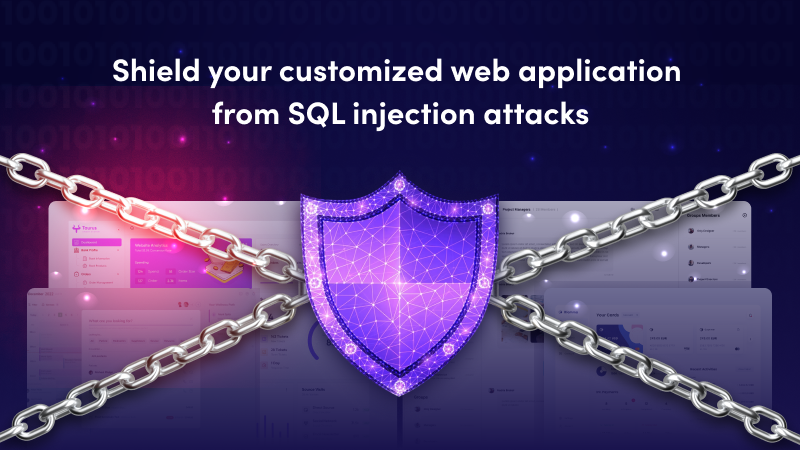
Best Practices for Securing Customized Web Applications against SQL Injection Attacks
The world is taking giant steps towards a more digital and interconnected network with the use of the latest technologies. The use of IoT, 5G technology, customized web application, AI, and quantum computing are creating endless opportunities. However, with such progress, there’s a growing risk of threats from various cyber attackers from around the world. As a result, customized web application attacks are commonplace now, and in this blog, we discuss the best practices to prevent SQL injection.
Before delving into how to prevent SQL injection, let’s take a look at the most common threats every customized web application faces.
3 Major Types of Web Application Attacks
Malware Attacks
Malware is a term used to classify every malicious program that intends to exploit the application for the hacker’s benefit. Spyware, Trojan, Ransomware, worms, and viruses are some of the popular types of malware. These threats use obfuscation and evasion techniques to trick the device security control into installing the program.
DDoS
Cyber attackers use DDoS, or Distributed denial of service, to make the web application unavailable to legitimate users. In a DDoS attack, the attacker floods the server with system requests, depleting the resources. Attackers sometimes use DDoS as a smokescreen for other attacks, such as malware or SQL injection.
SQL injection
As this blog primarily will discuss the best practices to prevent SQL injection, it is crucial to understand the threat first.
In SQL injection, the attacker injects malicious inputs into the server that uses SQL. It allows the attacker to dodge security measures and take away sensitive information and other data from a customized web application.
Best Practices to Prevent SQL Injection on Customized Web Applications
Strengthen Input Validation
Enabling client-side input validation is a good practice to consider. With this in place, you can prevent invalid input signals to the system logic. However, this mostly works for users who are genuinely out there to use the site without any malicious intentions. Giving the user direct feedback on invalid input dramatically enhances the user experience.
However, when we focus to prevent SQL injection, this method doesn’t bring much results.
There are numerous ways by which an attacker can easily bypass client-side validation. They can simply disable JavaScript in the browser or use tools such as Postman to send malicious HTTP requests directly to the server. To protect against SQL injection attacks, developers must validate all user input on the server-side. This involves checking the input for any suspicious characters or patterns that attackers could use to exploit a SQL vulnerability.
Developers can implement server-side validation using various techniques, including parameterized queries, stored procedures, and whitelisting. The specific approach best suited for a customized web application will depend on the specific database and programming language being used.
It is also important to note that not all SQL injection attacks can be prevented by server-side validation alone. For example, suppose an attacker is able to gain access to the database server itself. In that case, they may be able to exploit a SQL vulnerability even if the input has been validated on the server-side.
Third Party Authentication Tools
A popular web app solution to deal with such malicious attempts is using a third party authentication tool. These tools allow the users to access the site without having to remember their login credentials every time. Also, such tools save you the time and effort required to develop an authorization code yourself.
Solid Patching Protocol
Every company that works to develop website applications would agree that every customized web application will have its share of vulnerabilities. It is recommended to promptly implement patches provided by the vendors to keep it secure from threats. Keep in mind that hackers are aware of such patch announcements and are looking for folks who haven’t implemented the patch instantly.
Install Advanced Web Application Firewall
WAF or Web Application Firewall places itself between your customized web application and the related database. It inspects traffic to filter anything that looks malicious in intent. However, your partner Web App Support & Maintenance team should take up this work. This is because they exactly know how to fine-tune the firewall to offer advanced security without hampering user experience.
Use an ORM Layer
ORM or Object-Relational Mapping layer is a great measure to prevent SQL injection. The ORM layer works to transform the data from the database into objects. With an ORM library at work, explicit SQL queries are reduced; hence, your customized web application has less vulnerability.
Hibernate for Java and Entity Framework for C# are two prime examples of existing popular ORM libraries. The strongly typed nature of these languages makes it possible to generate the mapping between database tables and objects. In this manner, you do not even need to involve yourself in any SQL queries!
Another key thing to remember is to ensure a proper scan of these ORM libraries for known vulnerabilities. If you end up using a wrong or outdated version, it will land you in trouble eventually.
Blocklisting
While blocklisting is a popular technique to prevent sql injection, there’s something that needs your attention here. Implementing blocklist as a parameter has a specific issue that needs your attention. In a blocklist approach, developers must establish rules that define a vulnerable entry. If the input meets the set rules, the system blocks the request. However, the issue with customized web application is that if the rules are too weak, then a malicious entry is highly possible. On the other hand, if the rules are too strict, it might block the request of valid users of your platform.
This is why discussing the same with your partner web application development service provider is recommended. They are equipped with the knowledge and experience to make the blocklisting quite effective in order to prevent sql injection.
Some of the other popular practices to prevent sql injection on you customized web application are mentioned below-
Never miss any update as they are crucial to the security of the platform
- Follow secure coding practices
- Use CDN to its optimum level so that users do not get direct access to the server
- Keep a strong password policy accompanies by multi-factor authentication measures
- Install SSL and implement updated SSL security best practices
Conclusion
The techniques mentioned above to prevent sql injection definitely work well to prevent threats from entering your customized web application. However, the range of SQL attacks is increasing every day which is a major concern. Often it may happen that malicious sql codes will bypass some of these measures as well. Experts recommend using a combination of the aforementioned security measures for the best results. And to top it all, the addition of a web application firewall is a mandatory practice that keeps the security at place, every time!



